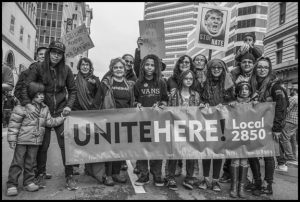
Local filmmaker Chris Ivey stands at the entrance to East Liberty, now marked by new development
Pittsburgh is poised for growth for the first time in 60 years. Will the city’s African-American community grow with it?
By Ryan Deto
Pittsburgh City Paper
It used to be that community activists, politicians and developers would fight over allowing the gentrification of city neighborhoods. If you eliminated affordable housing and replaced it with housing that was not as affordable, most people agreed it was at least the start of gentrification.
These days, the battle is apparently a little more nuanced.
On Nov. 5, for example, Mayor Bill Peduto tweeted: “So far Pittsburgh’s East Liberty neighborhood has avoided gentrification while reducing crime & improving investment,” with an accompanying study by local analytics firm Numeritics.
The study claims gentrification is “obviously not the case in East Liberty” because all new market-rate development happened on vacant land, and because neighborhood demographics from 2010 to 2013 remained the same.
However, Pittsburgh filmmaker Chris Ivey feels differently.
“The [report authors] certainly knew the story they wanted to tell and chose to ‘back up’ that story with the facts that happen to support it,” wrote Ivey, who documented the demolition of an East Liberty housing project in 2006, in an email to City Paper.
Ivey notes there has been a demographic shift in East Liberty since 2000, with the numbers of blacks declining three times as fast as whites, according to U.S. Census data. Census data also indicate that the northern tract of East Liberty lost hundreds of African-American residents since 2000, and that the median black income there went up 14 percent as a result — or, as Ivey puts it “poor blacks moved out.”
Another statistic foregone by the study was homeownership. According to statistics compiled by Pittsburgh Community Reinvestment Group (PCRG), from 2011 to 2014, East Liberty saw 55 homes purchased by whites, while only three homes were bought by blacks.
So while some may argue whether what’s gone on in East Liberty and other city communities is gentrification, one fact is uncontroverted: African Americans are leaving some of their long-time Pittsburgh neighborhoods in droves because they can no longer afford to live there, and that urban flight could get worse before it gets better.
With thousands of residential units slated for development, the city is seemingly poised for growth for the first time more than 50 years. But will Pittsburgh’s black population grow with it?
Historically, many African Americans came to Pittsburgh in the years between World War I and World War II. During this era of black migration, African Americans settled in the city neighborhoods of South Side, Garfield, East Liberty and Homewood, with the Hill District becoming the preeminent black neighborhood. (Continued)
Continue reading ‘Unfortunately in Pittsburgh, We Have a Tale of Two Cities.’



